Charles E W Bean, Diaries, AWM38 3DRL 606/248/1 - 1917 - 1931 - Part 6
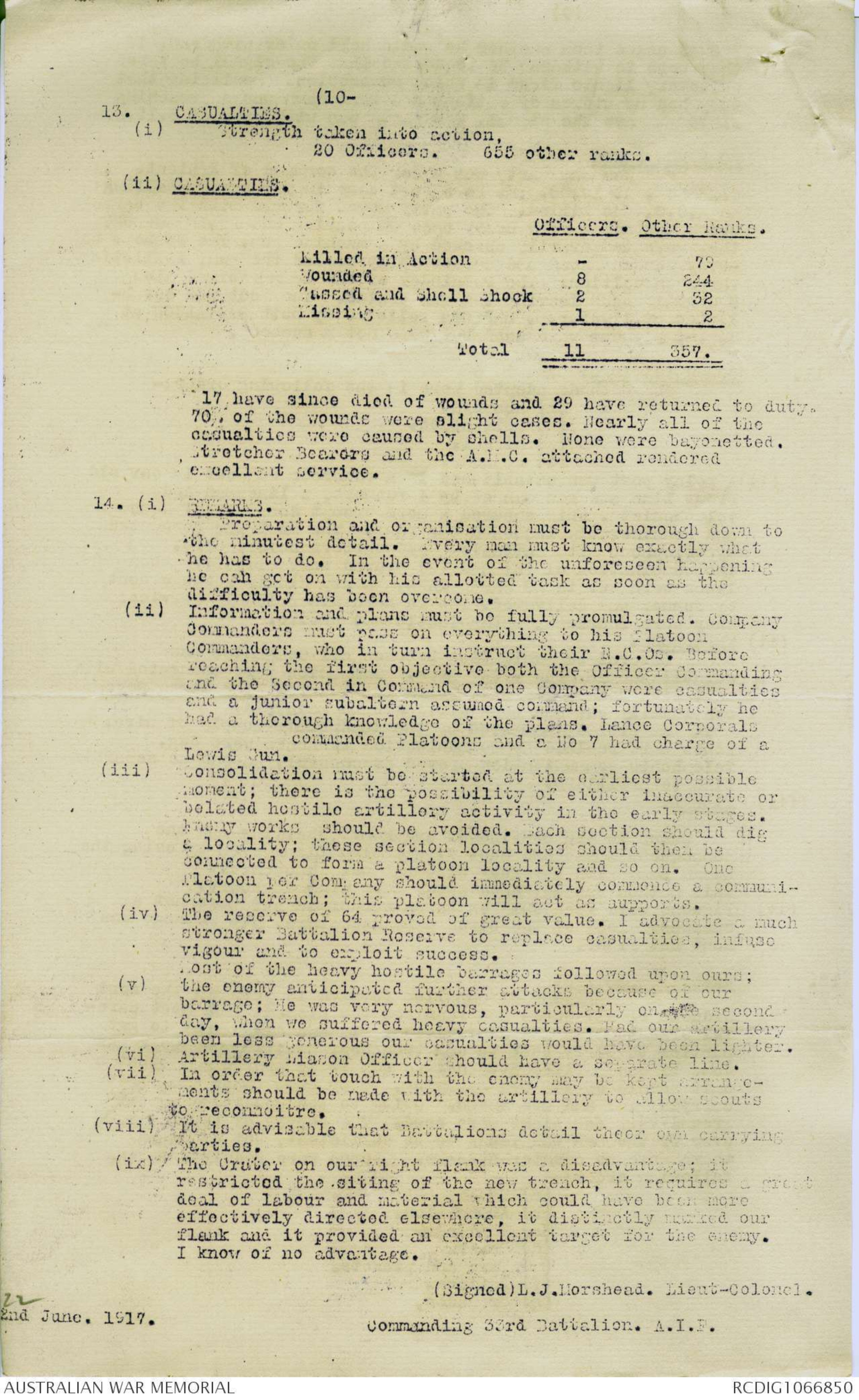
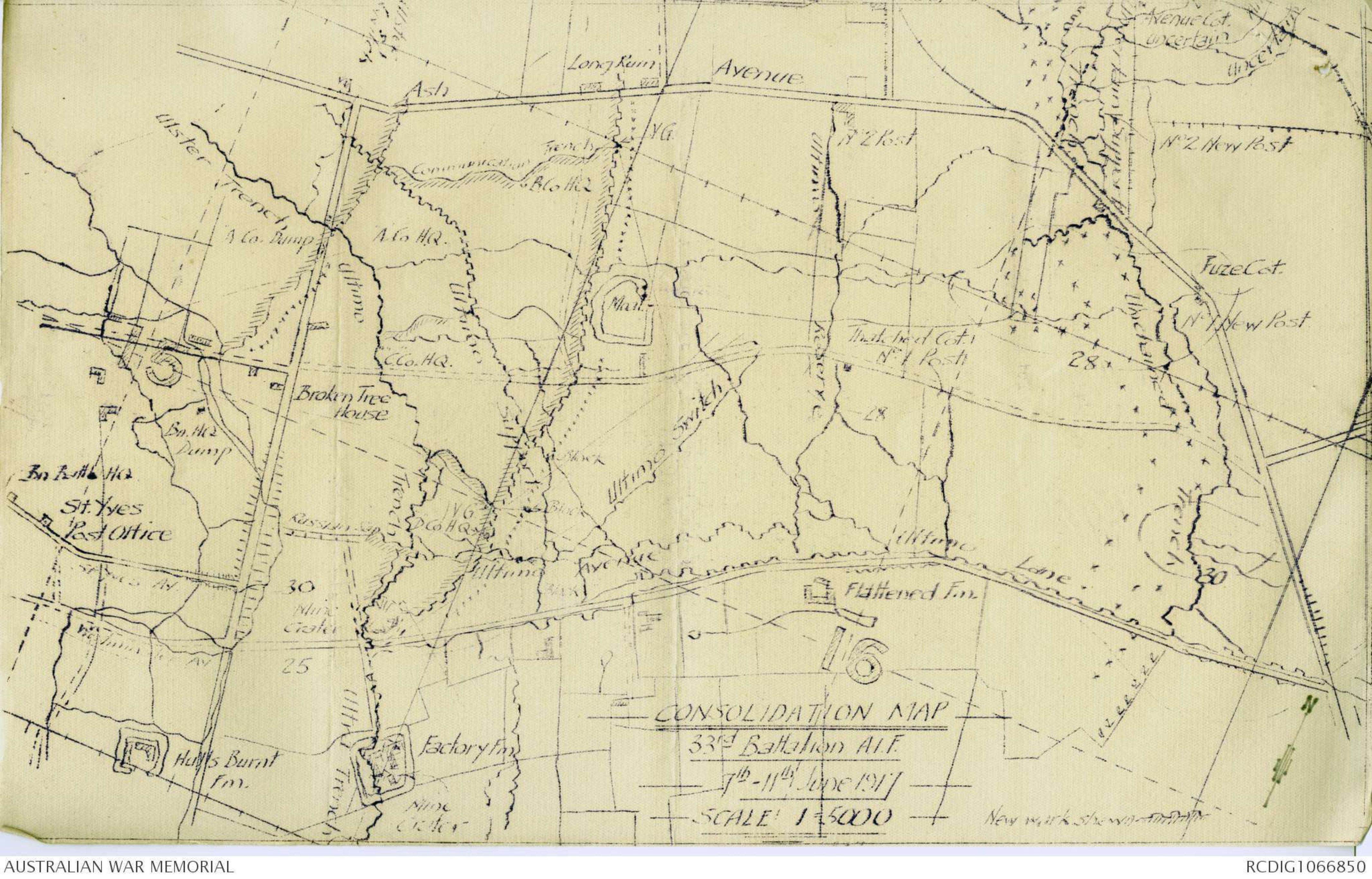


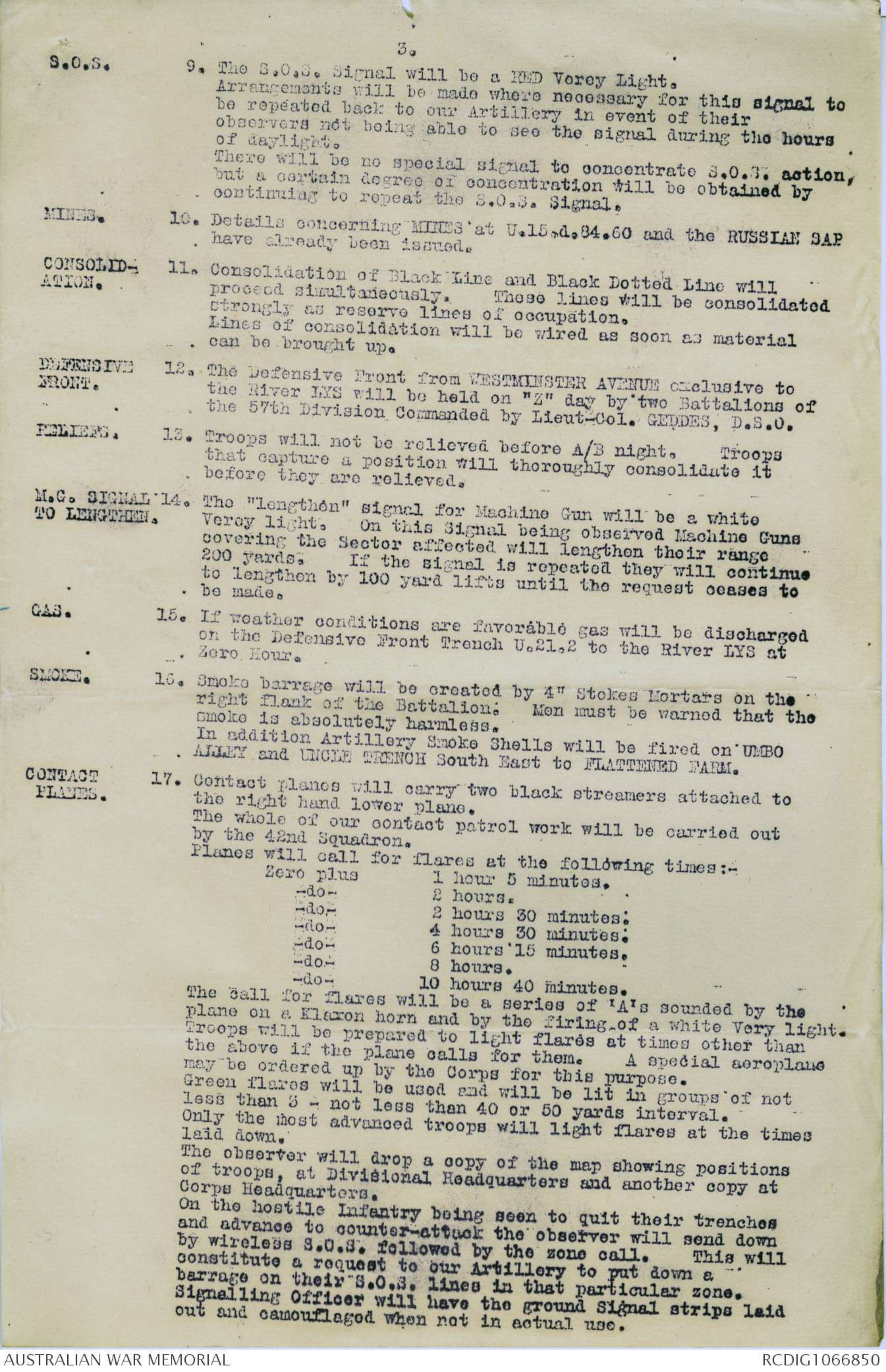

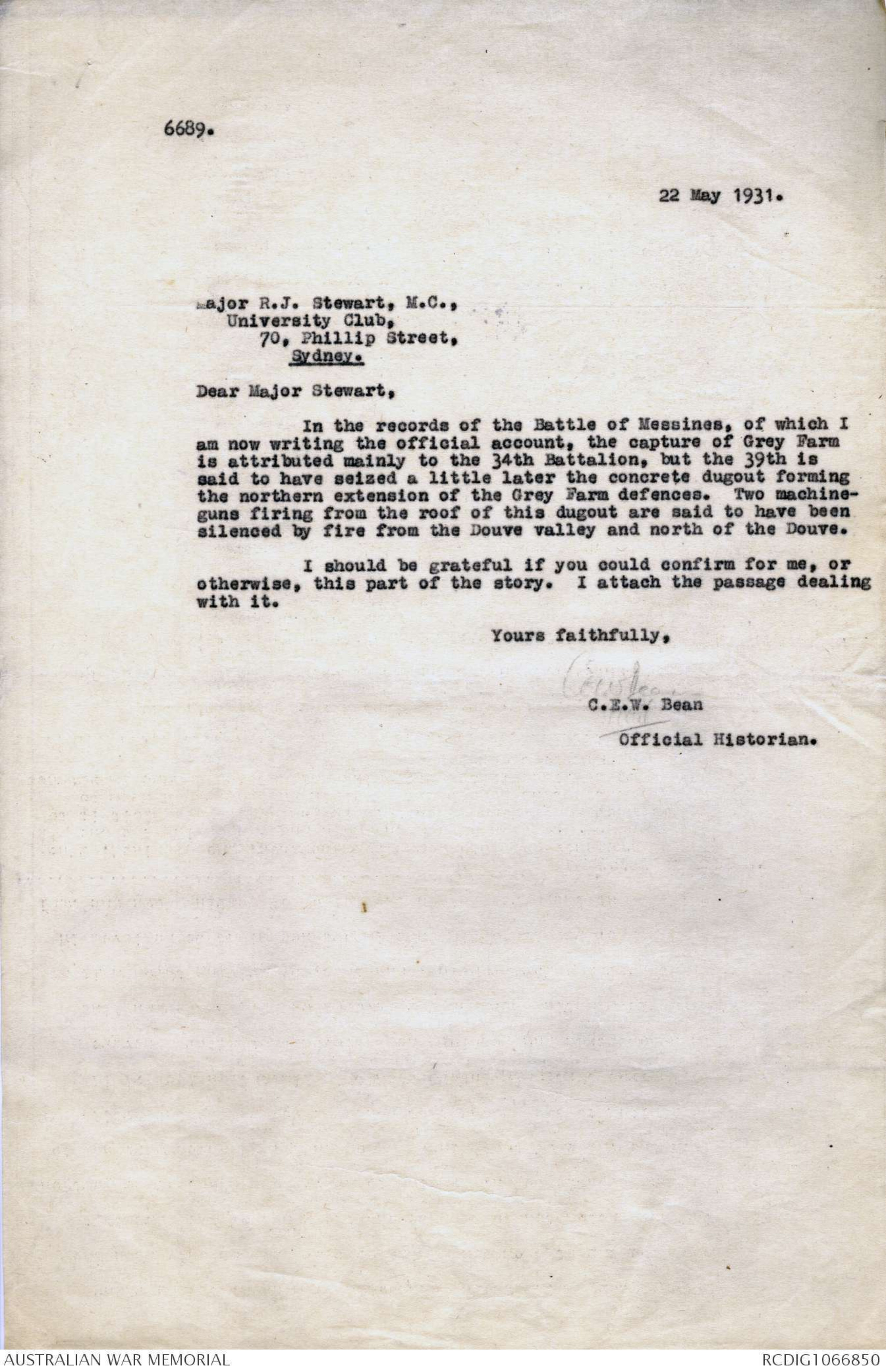

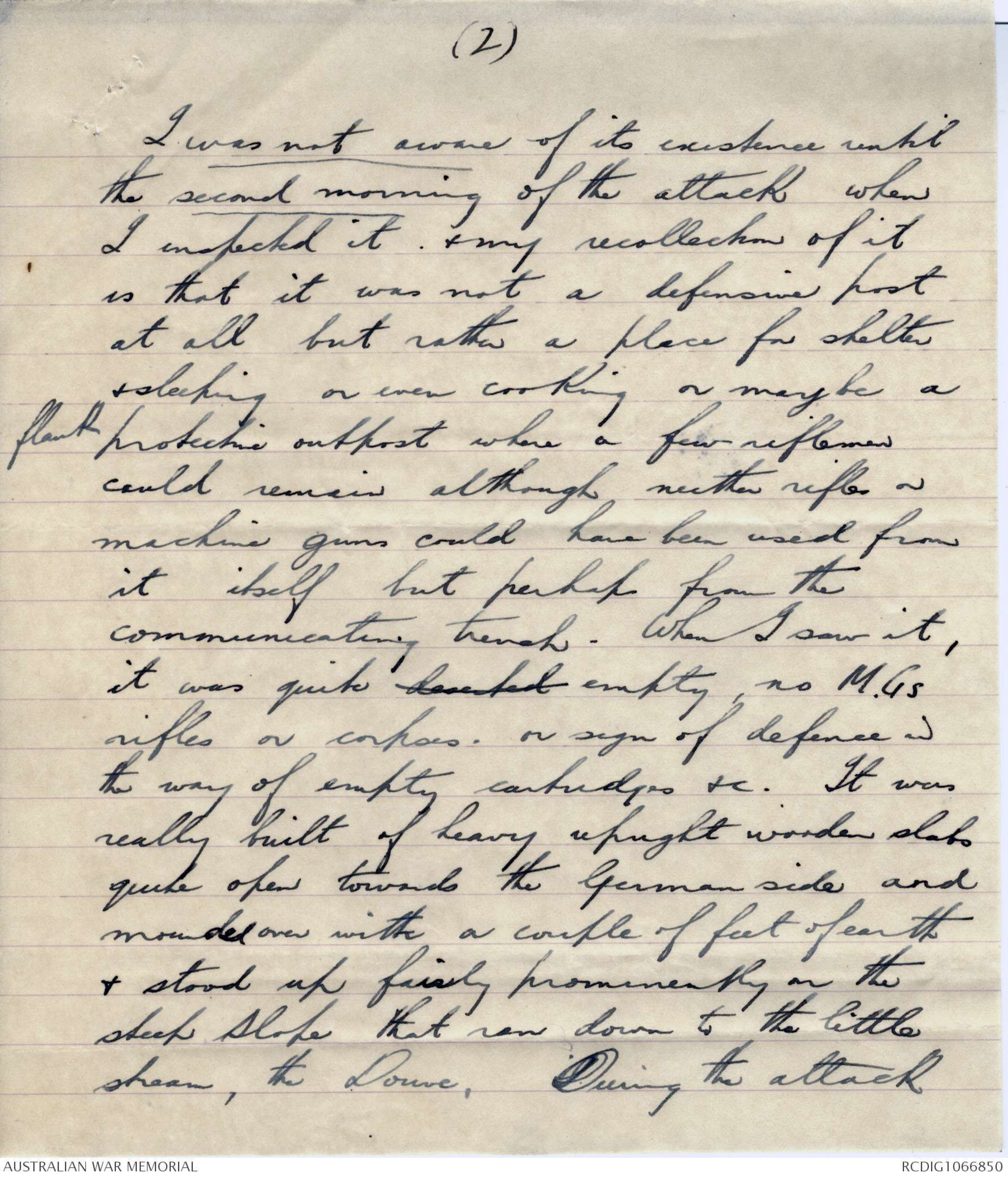

(10-
13. CASUALTIES.
(i) Strength taken into action
20 Officers. 655 other ranks.
(ii) CASUALTIES.
Officers Other Ranks.
Killed in Action - 79
Wounded 8 244
Gassed and Shell shock 2 32
Missing 1 2
Total 11 357.
17 have since died of wounds and 29 have returned to duty.
70% of the wounds were slight cases. Nearly all of the
casualties were caused by shells. None were bayonetted.
Stretcher Bearers and the A.M.C. attached rendered
excellent service.
14. (i) BEARERS.
Preparation and organisation must be thorough down to
the minutest detail. Every man must know exactly what
he has to do. In the event of the unforeseen happening
he can get on with his allotted task as soon as the
difficulty has been overcome.
(ii) Information and plans must be fully promulgated. Company
Commanders must pass on everything to his Platoon
Commanders, who in turn instruct their N.C.Os. Before
reaching the first objective both the Officer Commanding
and the Second in Command of one Company were casualties
and a Junior subaltern assumed command; fortunately he
had a thorough knowledge of the plans. Lance Corporals
commanded Platoons and a No 7 had charge of a
Lewis Gun.
(iii) Consolidation must be started at the earliest possible
moment; there is the possibility of either inaccurate of
belated hostile artillery activity in the early stages.
Enemy works should be avoided. Each Section should dig
a locality; these section localities should then be
connected to form a platoon locality and so on. One
Platoon per Company should immediately commence a
communication trench; this platoon will act as supports.
(iv) The reserve of 64 proved of great value. I advocate a much
stronger Battalion Reserve to replace casualties, infuse
vigour and to exploit success.
Most of the heavy hostile barrages followed upon ours;
(v) the enemy anticipated further attacks because of cur
barrage; He was very nervous, particularly on the second
day, when we suffered heavy casualties. Had our artillery
been less generous our casualties would have been lighter.
(vi) Artillery Liaison Officer should have a separate line.
(vii) In order that touch with the enemy be kept arrangements
should be made with the artillery to allow scouts
to reconnoitre.
(Viii) It is advisable that Battalions detail their own carrying
parties.
(ix) The Crater on our right Flank was a disadvantage, it
restricted the siting of the new trench, it requires a great
deal of Labour and material which could have been more
effectively directed elsewhere, it distantly marked our
flank and it provided an excellent target for the enemy.
I know of no advantage.
(Signed) L. J. Morshead. Lieut-Colonel.
[*22*]
2nd June. 1917.
Commanding 33rd Battalion. A.I.F.
Map - see original document
— CONSOLIDATION MAP —
33rd Battalion A.I.F.
— 7th - 11th June 1917 —
— SCALE: 1 = 5000 —
SECRET.
COPY No. 27
33RD BATTALION. A.I.F. ORDER NO. 40.
Reference Map : PLOEGSTEERT 28 S.W.
Ed.4.B.1/10,000.
Map 1 A ("Magnum Opus
Sketch") 1/5,000.
Headquarters ,
33rd Battalion; A.I.F.
June 5th, 1917.
INFORMATION. 1. (i) The enemy front opposite the 33RD BATTALION is at
present held by the 5th Bavarian Reserve I.R., 4th
Bavarian Division, Sixth Army
(ii) On a day to he known as "Z" day and at an hour to be
known as "Zero" the 2nd ARMY will advance to the
capture of the MESSINES - WYTSCHAETE RIDGE.
The 3rd Australian Division will capture and hold the
Southern portion of the Army objective, attack with
the 9th Infantry Brigade on the right, the 10th
Infantry Brigade on the left, and the 11th Infantry
Brigade in reserve.
The 9th Infantry Brigade will be responsible for the
capture of the Black and Green lines from the River
DOUVE Southwards.
The 33rd Battalion A.I.F will be responsible for the Right
Area of the Brigade (coloured RED in Map 1 A).
INTENTION. 2. The 33rd Battalion, A.I.F. will attack with "D"
Company plus one platoon from "A" Company, "C" Company
"B" Company and "A" Company less. one platoon.
APPROACH 3. This is the subject of a separate order.
MARCH.
ASSEMBLY AND 4. (i) The positions of assembly are already detailed in
DISPOSITIONS. "Instructions to Forthcoming Operations No.3".
(ii) The dispositions of the Battalion will be as. follows.
(a) RIGHT ASSAULTING COMPANY (Major H. F. WHITE)
D" Company and "Crater" platoon from "A" Co.
6 Lewis Guns.
1 Stokes Mortar.
1 Vickers Gun
(b) CENTRE ASSAULTING COMPANY. (Capt. C. H. LINKLATER)
"C" Company.
5 Lewis Guns.
1 Stokes Mortar.
(c) LEFT ASSAULTING COMPANY. (Capt. S. F. SORERSEN).
"B" COMPANY.
4 Lewis Guns.
1 Vickers Gun.
(d) SUPPORT COMPANY. (Capt. W. H. DOUGLAS).
"A" Company less 1 platoon.
3 Lewis Guns.
(e) BATTALLON RESERVE; (2nd Lt. E. C. P. THOMAS)
64 men (16 from each Company).
20 Scouts.
4 Lewis Guns.
TASKS. 5. 33RD BATTALION will capture the enemy Front and
Support Lines, clear the ground in Right Area (coloured
RED in map No.1/A) and consolidate on the BLACK
LINE 'L.M.N, the new SUPPORT LINE P.Q. and the crater
at U.15.d.84.60.
Companies tasks are as follows:
(i) "D" Company, (Right Assaulting Company).
(A) In the event of a crater at U.15.d.84.60 being formed:
(a) To capture the enemy's Front Line from U.15.d.86.50
to U.15.b.65.18 and his Support Line from U.16.c.18.92.
to U.15-b:88.36.
(b) To capture and consolidate the mine crater to be
formed at U.15.d.84.60.
(c) To capture and consolidate on the BLACK LINE from
U.15.b.95:I2 to U.15.2.51.38 putting the enemy's Front
Line at U.15.d.86.51.
(d) To clear all the ground in the Company area.
2.
(e) To establish Bombing Blocks at
U.15.d.92.42.
U.16.c.03.64.
U.16.c.02.88.
U.16.a.02.00.
U.15.d.09.19. (to be later
taken over by "C" Co.)
(B) In the event of the mine at U.15.d.84.60 failing to
explode
(a) To capture the enemy's Front Line from U.15.d.81.60
to U.15.b.65.18 and his Support Line from
U.15.c.18.92 to U.15.b.8.36.
(b) To capture and consolidate on the BLACK LINE from
U.15.b.95.12 to U.l5.d.55.47 cutting the enemy's
Front Line at U.l5.d.81.60.
(c) To clear all the ground in the Company area.
(d) To establish Bombing Blooks at -
U.15.d.86.51.
U.16.c.02.88.
U.16.a.02.00.
U.16.a.09.19. (to be taken
over later by "C" Co.)
(ii) "C" Company (Centre Assaulting Company)
(a) To capture the enemy's Front Line from U.15.b.65.18
to U15.b.40.50 and his Support Line from
U.15.b.88.36 to U.15.b.60.67.
(b) To capture and consolidate on the BLACK LINE from
U.15.b.95.12 to U.15.b.95.69.
(c) To clear all the ground in the Company area.
(d) To establish Bombing Blocks first at U.16.a.20.72
and when the barrage allows at U.16.a.20.77.
To take over the Bombing Block established by "D"
Company at U.16.a.09.19.
If necessary to establish a block at U.14.a.20.77.
(iii) "B" Company (Left Assaulting Company)
(a) To capture the Enemy's Support Line from U.15.b.60.67
to U.15.b.22.82.
(b) To capture and consolidate on the BLACK LINE from
U.15.b.95.69 to U.9.d.85.40.
(c) To clear all the ground in the Company' area from the
enemy's Support Line to the Black Line.
(iv) "A" Company (Support Company)
(a) To capture the enemy's Front Line from U.15.b.40.50
to U.15.b.05.56.
(b) To clear all the ground in the Company Area up to the
enemy’s Support Line.
(c) To consolidate a Support Line from U.15.b.42.70 to
U.I5b.5.10; cutting the enemy's Front Line at
U.15.b.32.51.
METHOD OF 6. At Zero the Artillery Barrage will be put down and the
ATTACK. Infantry will leave their Assembly Trenches. Every
endeavour will be made to get the last wave into No MAN'S
LAND as quickly as possible.
TIMINGS OF 7. Barrage maps have been issued to all Companies.
BARRAGE.
PROTECTIVE 8. In protective barrages fire will not be kept on the same
BARRAGE. points the whole time, a system of searching and sweeping
will be employed up to a depth of 1000 yards, so that the
ground in front of the Infantry may be searched and enemy
movement stopped in this area. During the protective
barrage for the Black Line only 50% of the advancing barrage
will be used as above. The guns detailed to carry out this
work will only do so when all guns of the protective barrage
in a Group are firing, thus Infantry in addition to their
watches will have some guide to indicate the line beyond
which it would be unsafe to advance.
The guns detailed to search and sweep will not be employed
on this work within half an hour of the whole barrage having
to move forward according to time table.
3.
S.O.S. 9. The S.O.S. Signal Will be a RED Verey Light.
Arrangements will be made where necessary for this signal to
be repeated back to our Artillery in event of their
observers not being able to see the signal during the hours
of daylight.
Thero will be no special Signal to concentrate S.O.S. action,
but a certain degree or concentration will be obtained by
continuing to repeat the S.O.S. Signal.
MINES. 10. Details concerning MINES at U.15.d.34.60 and the RUSSIAN SAP
have already been issued.
CONSOLIDATION. 11. Consolidation of Black Line and Black Dotted Line will
proceed simultaneously. Those Lines will be consolidated
strongly as reserve lines of occupation.
Lines of consolidation will be wired as soon as material
can be brought up.
DEFENSIVE 12. The Defensive Front from WESTMINSTER AVENUE exclusive to
FRONT. the River LYS will be held on "Z" day by two Battalions of
the 57th Division Commanded by Lieut-Col. GEDDES, D.S.O.
RELIEFS. 13. Troops will not be relieved before A/B night. Troops
that capture a position will thoroughly consolidate it
before they are relieved.
M.G. SIGNAL 14. The "Lengthen" signal for Machine Gun will be a white
TO LENGTHEN. Verey Light. On this Signal being observed Machine Guns
covering the Sector affected will lengthen their range
200 yards. If the signal is repeated they will continue
to lengthen by 100 yard lifts until the request ceases to
be made.
GAS. 15. If weather conditions are favourable gas will be discharged
on the Defensive Front Trench U.21.2 to the River LYS at
Zero Hour.
SMOKE. 16. Smoke barrage will be created by 4" Stokes Mortars on the
right flank of the Battalion: Men must be warned that the
smoke is absolutely harmless.
In addition Artillery Smoke Shells will be fired on UMB0
ALLEY and UNCLE TRENCH South East to FLATTENED FARM.
CONTACT 17. Contact planes will carry two black streamers attached to
PLANES. the right hand lower plane.
The whole of our contact patrol work will be carried out
by the 42nd Squadron.
Planes will call for flares at the following times:-
Zero plus 1 hour 5 minutes.
-do- 2 hours.
-do- 2 hours 30 minutes.
-do- 4 hours 30 minutes.
-do- 6 hours 15 minutes.
-do- 8 hours.
-do- 10 hours 40 minutes.
The Call Tor flares will be a series of 'A's sounded by the
plane on a Klaxon horn and by the firing of a White Very light.
Troops will be prepared to light flares at times other than
the above if the plane calls for them. A Special aeroplane
may be ordered up by the Corps for this purpose.
Green flares will be used and will be lit in groups of not
less than 3 - not less than 40 or 50 yards interval.
Only the most advanced troops will light flares at the times
laid down.
The observer will drop a copy of the map showing positions
of troops, at Divisional Headquarters and another copy at
Corps Headquarters.
On the hostile Infantry being seen to quit their trenches
and advance to counter-attack the observer will send down
by wireless S.O.S. followed by the zone call. This will
constitute a request to our Artillery to put down a
barrage on their S.O.S lines in that particular zone.
Signalling Officer will have the ground Signal strips laid
out and camouflaged when not in actual use.
4.
ARTILLERY 18. Should the enemy attempt to bombard our trenches within 30
ACTION minutes of ZERO hour the Field Artillery will not reply to the
PRIOR TO S.O.S. Signal, in order that there may be no danger of the
ZERO. Infantry mistaking our retaliatory action for the opening
of the Barrage.
Field Artillery retaliatory action will be normal during the
rest of Y/Z night.
Arrangements have been made by Corps Artillery that any
bombardment of our trenches during Y/Z night shall be
countered by prompt and overwhelming counter-battery action.
SYNCHRONISATION. 19. From this day to Z day an Officer from Battalion Headquarters
will visit Company Headquarters in order to synchronise
watches. The Official watches must be available at
Company Headquarters at all times, for this purpose.
REPORTS. 20. Reports to Battalion Headquarters, BRISTOL CASTLE,
ST YVES TUNNELS.
21. ACKNOWLEDGE.
R. C. Jones. Lieut.
Adjutant, 33rd Battalion, A.I.F.
Issued at p.m. by runner.
Copy No. 1. 9th Inf. Bde.
2. C.O.
3. A. Co.
4. B. Co.
5. C. Co.
6. D. Co.
7. Signalling Office.
8. Quartermaster.
9. Transport Officer.
10. R.M.O.
11. 9th A.L.T.M.Bty.
12. 9th A.M.G.Co.
13. 9th Field Co.
14. 34th Bn. A.I.F.
15. 35th Bn. A.I.F.
16. 36th Bn. A.I.F.
17. 42nd Bn. A.I.F.
18. 43rd Bn. A.I.F.
19. Lt.CoL-GEDDES, D.S.O., O.C. Defensive Battalions.
20. File
21-22. War Diary.
23-27. Spare.
6689.
22 May 1931.
Major R. J. Stewart, M.C.,
University Club
70, Phillip Street,
Sydney.
Dear Major Stewart,
In the records of the Battle of Messines, of which I
am now writing the official account, the capture of Grey Farm
is attributed mainly to the 34th Battalion, but the 39th is
said to have seized a little later the concrete dugout forming
the northern extension of the Grey Farm defences. Two machineguns
firing from the roof of this dugout are said to have been
silenced by fire from the Douve valley and north of the Douve.
I should be grateful if you could confirm for me, or
otherwise, this part of the story. I attach the passage dealing
with it.
Yours faithfully,
C.E.W. Bean
C. E. W. Bean
Official Historian.
C/o Bank of N.Z.
Wellington N.Z.
10/6/31
The Historian
Victoria Barracks
Paddington N.S.W.
Dear Doctor Bean,
I have just received your
letter of the 22 May redirected to me over
here - I am at present touring N.Z. so
you will readily understand my delay
in replying.
I have had to exercise my
memory somewhat to recollect the
exact happenings at the taking of Grey
Farm during the Messines attack & at
first could not "place" the ""dugout
forming the northern extension of the Grey Farm
defences" but now feel sure that same
refers to the small shelter dugout, or
living dug out, as shown on the
accompanying rough sketch
(2)
I was not aware of its existence until
the second morning of the attack when
I inspected it & my recollection of it
is that it was not a defensive post
at all but rather a place for shelter
& sleeping or even cooking or may be a
flank protective outpost where a few riflemen
could remain although neither rifles or
machine guns could have been used from
it itself but perhaps from the
communicating trench. When I saw it
it was quite deserted empty, no M.GS
rifles or corpses. or sign of defence in
the way of empty cartridges & c. It was
really built of heavy upright wooden slabs
quite open towards the German side and
mounded over with a couple of feet of earth
& stood up fairly prominently on the
steep slope that ran down to the little
stream, the Douve, During the attack
(3)
the whole first day of the attacks & the
forenoon of the second day we saw no I did notsign notice any of our troops North of the Douve
& but abt. 4 P.M (I think) on the
second day we saw a thin wave of
Australian troops advancing in the open
past our left. on the high ground N. of Douve
In fact on the afternoon of the
first day, one of my "prospecting"
N.C.Os (scouts) reported that our left
flank was in the "air" with no sign
of other troops across the stream to our
left & I remember ordering a Lewis
Gun section to go out to our left
front & on the bank of the Douve
to face N.E. & be prepared to protect
our exposed flank & they remained
there until & we saw the troops mentioned
above. The objective of my companyof course as alloted was Grey Farm
 Deb Parkinson
Deb ParkinsonThis transcription item is now locked to you for editing. To release the lock either Save your changes or Cancel.
This lock will be automatically released after 60 minutes of inactivity.